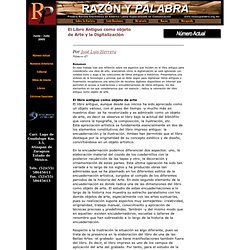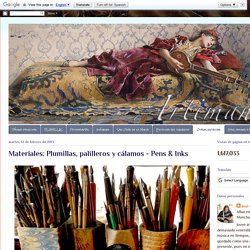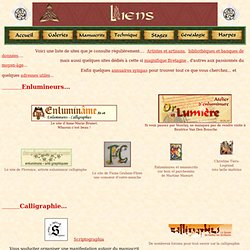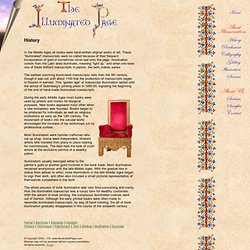

El Libro Antiguo como objeto de Arte y la Digitalización. Por José Luis Herrera Número 45 Resumen En este trabajo tras una reflexión sobre los aspectos que inciden en el libro antiguo para considerarlo una obra de arte, analizamos cómo la digitalización se está aplicando con notable éxito y auge a las colecciones de libros antiguos e históricos.

Presentamos una síntesis de la tecnología y proceso que se debe seguir para digitalizar libros antiguos y finalmente recopilamos una selección de recursos digitales disponibles en Internet que permiten el acceso a ilustraciones y encuadernaciones de libros antiguos, los dos elementos en los que consideramos que -en esencia-, radica la valoración del libro antiguo como objeto de arte. Materiales: Plumillas, palilleros y cálamos - Pens & Inks. Últimamente casi todos los dibujos con tintas los hago con pluma estilográfica.

Cargo varias con tintas de diferentes colores y con ellas y un pincel de agua en cualquier sitio puedes dibujar con comodidad. Pero resulta que me encanta utilizar las plumillas, que tengo muchas y que para muchas cosas son infinitamente mejores que una estilográfica o un rotulador. De forma que, estando en casa, he colocado encima de la mesa algunas plumillas y palilleros y me he puesto a disfrutar eligiendo, probando y viendo lo bonitas que son. Aunque tengo muchos palilleros sin estrenar, prefiero los que he comprado usados, normalmente en lotes, antiguos y cada uno con su historia, desconocida pero real, como las manchas de tinta que tenían cuando los compré. Parte del placer de escribir, dibujar y pintar, al menos para mi, me lo proporcionan los materiales.
Bueno, a lo que vamos. The Great Calligraphy Catalogue. Enluminures celtes, mes liens. Calligraphie...

Sources... Ô Magnifique Bretagne et monde celtique... Le Moyen-âge...et autres coups de cœur ! Illuminated manuscript (art) Illuminated manuscript, handwritten book that has been decorated with gold or silver, brilliant colours, or elaborate designs or miniature pictures.

Though various Islamic societies also practiced this art, Europe had the longest and probably the most highly developed tradition of illuminating manuscripts. A brief treatment of illuminated manuscripts follows. For full treatment, see painting, Western: Western Dark Ages and medieval Christendom. The term “illumination” originally denoted the embellishment of the text of handwritten books with gold or, more rarely, silver, giving the impression that the page had been literally illuminated. Illumination History. In the Middle Ages all books were hand-written original works of art.

These “illuminated” manuscripts were so called because of their frequent incorporation of gold or sometimes silver leaf onto the page. Illumination comes from the Latin word illuminare, meaning “light up,” and when one sees one of these brilliant manuscripts in person, the term makes sense. The earliest surviving illuminated manuscripts date from the 5th century, though it was not until about 1100 that the production of manuscripts began to flourish in earnest. This “golden age” of manuscript illumination lasted until the arrival of Gutenberg’s printing press in 1450-55, signaling the beginning of the end of hand-made illuminated manuscripts. During the early Middle Ages most books were used by priests and monks for liturgical purposes. Most illuminators were humble craftsmen who set up shop.
Illuminators usually belonged either to the painter’s guild or another guild involved in the book trade. 2. Rough Edge Gilding. Before we go ahead and sew the book there is time to decide if we want to treat the edge to some form of decoration.

There are many types of edge treatment and they can be applied at different stages of the binding process. The process I am going to show you here is a form of gilding known as Rough Edge Gilding. I found this technique in Jen Lindsay’s Fine Bookbinding a Technical Guide, which I highly recommend. This is the only gilding technique I have tried, as the others quite frankly scare me, and although it’s a little tricky it’s not overly complicated. The overall look of a Rough Edged Gilt book is a lot more natural in appearance to a Solid Gilt Edge, and a lot more forgiving to the binder. I’m only going to gild the head of this book but you could gild all three edges if you wished.
Firstly we need to give each section a liberal dusting of French Chalk along the edge to be gilded. Musée du Parchemin et de l'Enluminure (Rouillon - Sarthe)